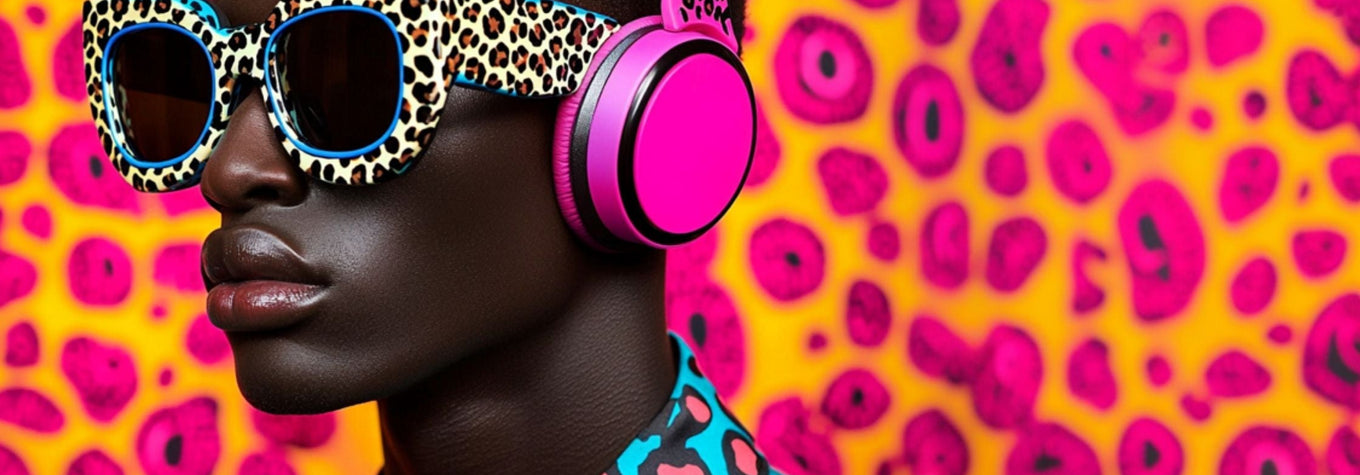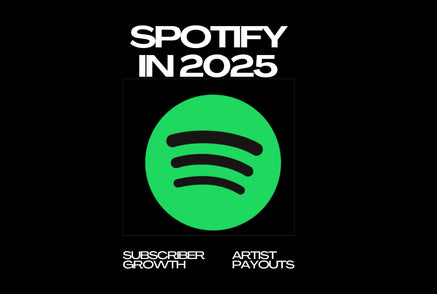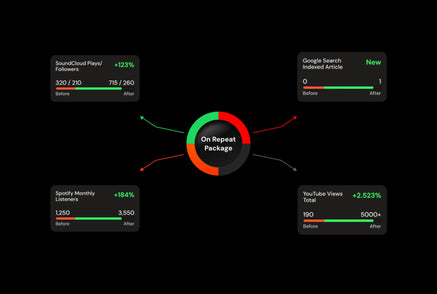How does Spotify Algorithm work for artists?
In 2014, Spotify made a strategic move that changed everything. The platform acquired Echo Nest, a music data platform for music identification, recommendations, playlists, and analytics. After that, Spotify switched to an AI-based algorithm, using the power of machine learning and natural language processing. In the first quarter of 2023, Spotify had about 515 monthly active users, compared to 68 million in the first quarter of 2015. This indicates a rapid increase in the effectiveness of the new algorithm system.
Every analysis of songs and artists, auditory characteristics, and construction of categories based on tempo, genre, mood, duration, and other factors is performed by artificial intelligence. In addition, Spotify's recommendation system is now based on a new technique: collaborative filtering. Essentially, it turns each song into a dot on a map, identifying user behavior patterns when listening to music on the platform.
Such changes seriously affected the activities of artists. It is extremely important for newcomers to understand how the platform recommends their songs to users and what they can do to maximize engagement. In this article, we will provide an in-depth explanation of the Spotify algorithm’s work and explain how to use it to your advantage.
|
Aspect of Spotify Algorithm |
Short Description |
Key Points |
|
User Interaction |
The algorithm adapts to the user’s behavior. Whether you listen, save, like tracks, or add them to playlists. |
Frequent interactions with specific tracks or artists increase their recommendation rate. |
|
Collaborative Filtering |
Collaborative filtering is used to analyze listening habits and create better recommendations. |
If users with similar tastes listen to a song, it’s more likely to be recommended to others in that group. |
|
Natural Language Processing (NLP) |
The algorithm scans blog posts, articles, and other content, analyzing language patterns related to music. |
How often a song or artist is mentioned in external sources can affect its likelihood of being recommended. |
|
Audio Analysis |
Deep analysis of the audio, including tempo, loudness, length, and danceability to determine sonic attributes. |
Tracks with similar audio characteristics are more likely to be recommended based on previous listening patterns. |
|
Release Radar & Discover Weekly |
These playlists are formed based on used data. These mixes receive weekly updates to offer fresh recommendations. |
Release Radar focuses on new releases from artists you follow, while Discover Weekly suggests new music based on habits. |
|
Contextual Playlists |
Playlists for mood, activity, or time of the day. |
These playlists help align music suggestions with specific user contexts, like workouts or relaxation. |
|
User’s Social Networks |
The algorithm analyzes the activity of your friends and people you follow to uncover music you haven’t heard yet. |
Interacting with friends or following playlists curated by others can influence personalized recommendations. |
|
Trending and Popularity Metrics |
The algorithm spots global and local trends to create recommendations. |
Highly popular or trending songs may appear in recommendation lists, even if they deviate from a user’s typical genre. |
General aspects of Spotify algorithm and explanation for each point.
What do we know about the Spotify Algorithm?
The Spotify algorithm is not just a number of commands. It's a complex system based on machine learning that personalizes the music-listening experience for every user. Such personalization becomes available due to the system's working algorithms based on the following factors:
Users' Preferences
By preferences, we mean the time of the day a person listens to music, the length of one listening session, and even the devices on which they listen to the music. The system provides better recommendations (songs and playlists) by analyzing this information.
Machine Learning
The system uses machine learning to analyze the information and generate a personalized playlist for each individual. Personal preferences and favorite genres are taken into account. For instance, if a person frequently listens to rap or trap, Spotify will offer songs from these genres.
Collaborative Filtering
What does that mean in the context of Spotify algorithms? It means that other users' listening habits are also considered. The system analyzes the preferences of individuals with the same music tastes or who listen to the songs of similar artists.
Content-based Filtering
There's also content-based filtering that analyzes the tracks with spectrograms. Simply put, it's a picture of music. The music is converted into a mel spectrogram and passed through a convolutional neural network (CNN).
Content-based filtering is a breakthrough technology as it resolves the "cold start problem" when new songs don't get enough recommendations to be seen by listeners. Because collaborative filtering is based on listening data, popular songs monopolize recommendations.
In the video below, you can find a detailed explanation of collaborative and content-based filtering. The author illustrates both filtering methods with examples and formulas.
Natural Language Processing (NPL) examines news articles, reviews, and blog posts to form a list of the most used descriptions for an artist or a song. Each description is called a “cultural vector” and defines the weight of this description for a particular song or musician.
Such a method is used to find common details between songs, musicians, and people’s preferences. Spotify collects vast amounts of data from users’ profiles and uses machine-learning models to recommend familiar songs weekly.
How Does Spotify Algorithm Work for Artists?
Spotify algorithms differ for listeners and artists. Users get new recommendations based on the analysis of an AI. Artists then need to use the Spotify algorithm to give them more profit and recommend their songs to more users.
Audience engagement is crucial because it’s the primary metric for Spotify to evaluate the songs. The critical points involved in audience engagement are:
- Total number of streams
- Number of streams per listener
- Saves
- The number of playlists added
- Total number of listeners
Besides these points, there are also additional metrics used by Spotify to rank artists:
- Length of time listening
- The overall number of shares
- The already mentioned Natural Language Processing
Let’s have a detailed look at each point.
Shares
All shares on Spotify are tracked. The system sees the resources used to share the song (Telegram, Whatsapp, etc.) and how often the shares are done. These statistics are available for artists in their Spotify Wrapped, revealing the detailed statistics and using the data for further recommendations. If your song has been shared multiple times, the AI will likely use collaborative filtering technology to show it to listeners with similar listening habits.
Length of Listening
The more people listen to your song from the beginning to the end, the more times it will be recommended. Still, if users skip it at the beginning or when listening to it multiple times, this won’t make the algorithms work properly.
Natural Language Processing
The NLP works exactly as we described before. The system aims to find how people discuss the track and how they mention it in social media or blogs. Natural Language Processing also divides songs into categories, giving each one a descriptive adjective for further classification.
Spotify’s algorithms evolve as new AI-driven technologies are implemented to optimize all the processes. In the Wall Street Journal video, you can find more information about Spotify’s recommendation. For example, the platform uses user-driven data to create a map of songs and artists. It also reveals how the technology will evolve in the near future.
How to Use Spotify Algorithm to Your Advantage?
Knowing how the Spotify algorithm works is only half of the success. You should use this algorithm to your advantage to make more users see your songs. We will answer the question: how to train the Spotify algorithm?
Profile optimization
Spotify analyzes user data and uses this information in its algorithms to give listeners better recommendations. Create an engaging profile with gigs and pictures. Add an artwork that grabs attention and put links to all your social media in the bio. It's essential because the more people engage with your profile, the more chances there are for you to have new listeners and subscribers. Make your profile recognizable and easy to find by adding memorable images or pictures to the main page and released songs.
Get your music on top by creating multiple Spotify playlists. Playlisting always makes the profile more recognizable by showing compilations of tracks united by a single idea, topic, theme, or other criteria. If listeners enjoy the first song on the list, they'll probably move to the next one. Breakthrough songs can also attract the attention of playlist curators. Skilled curators will pitch your music and make it get more streams, boosting the recommendation engine and helping you get to the next level.
Work with statistics
Analyzing Spotify's raw data and all the statistics about your profile is essential. The platform always analyzes how users engage with tracks and profiles to give them better recommendations. Pay attention to the skip rate, listening time, playlist features, and history. If people don't skip your track in the first 30 seconds, it's a positive signal that keeps your skip rate low. Still, if you struggle at the beginning and want to get a boost for your Spotify profile, you can have 10,000 Spotify Premium Royalty plays as your songs move to the top of the chart.
Remember about the timing
The first 24 hours after the track's release are crucial. In this timeframe, you need to get the most listens and keep the skip rate low. Make people excited about the song so they will listen and save your song on the first day. The best option is to release your songs on Friday. On this day, Spotify has the highest activity, which is a chance for you to get the highest chart potential. The higher your chart potential is, the more listeners will pay attention to your music, and you also get a chance to be featured on Discover Weekly, Best of the Week, New Music Friday, or Release Radar.
For example, the Release Radar will boost your track’s stream count. The listeners who use this feature will get a notification about the new release, and they will likely try to listen to it. If the initial reaction is positive, the song will be shared across social media, so you will get more streams and have high engagement. Every song can make a difference once you publish and promote them properly, getting maximum engagement during the first day.
Label the Tracks
Share all the information about the track so the platform will put all the needed labels. Spotify determines where the track fits in, what genre it is, and to whom it should be shown. Still, be careful and don’t include any unnecessary data in the description.
Rely on Spotify’s Tools
To use all the benefits of Spotify algorithms even better, consider using a special toolkit. There are 4 basic instruments you should remember about.
- Canvas allows you to add some visual elements to the song as it will be more dynamic and beautiful.
- Spotify for artists becomes crucial as it gives you access to analytics audience engagement and allows you to control your Spotify appearance.
- Create a storyline for your album or a single song. That’s what fans like.
- Promo Cards. Be unusual when sharing your albums and songs. Your posts will look solid, and people will recognize you as a professional artist.
It takes time to master tools and create your unique style. Once you become familiar with every instrument in your arsenal, you will seriously boost your profile. However, if you feel like it’s not enough, you can get an additional Spotify promotion to gain listeners and subscribers faster. You directly impact the Spotify recommendation system, as your tracks will be discovered by more users, raising the engagement metrics. It also raises chances on appearing in personal Playlists like Discover Weekly and Release Radar.
Final thoughts
Mastering Spotify may look tough due to the solid amount of information you need to process. As an artist, you must create the best presentation of your product and achieve the best audience engagement. It not only puts your songs on various charts but also opens doors for monetizing your content. Moreover, understanding the Spotify algorithm is an essential part of music release. Once you understand the key features of the algorithm and how to use them to your advantage, the faster you'll get new music fans and achieve new heights in the music industry. The faster you realize what algorithm Spotify uses, the faster you’ll succeed.
What is the Spotify Algorithm?
What are the triggers for the Spotify Algorithm?
What Algorithmic Playlists are available on Spotify?
What is Spotify Radio?






















Noah Gallagher
Good read overall. The Spotify algorithm always felt like a mystery, but this article clears up quite a few things.
Good read overall. The Spotify algorithm always felt like a mystery, but this article clears up quite a few things.
Paul Woolf
Thanks for simplifying the Spotify algorithm for artists. It’s refreshing to see how technology is influencing music discovery. The section on ‘Shares’ and ‘Length of Listening’ was particularly insightful. Looking forward to applying these tips to enhance my presence on Spotify!
Thanks for simplifying the Spotify algorithm for artists. It’s refreshing to see how technology is influencing music discovery. The section on ‘Shares’ and ‘Length of Listening’ was particularly insightful. Looking forward to applying these tips to enhance my presence on Spotify!
Artur Digital
Thanks. I needed to figure out how Spotify algorithms work; it was helpful.
Thanks. I needed to figure out how Spotify algorithms work; it was helpful.